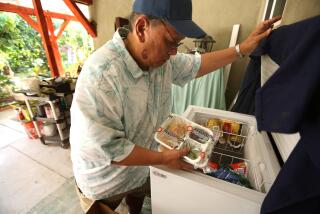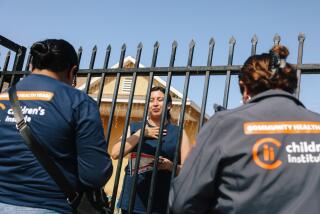For Families on the Fringe, Good Cheer Is Hard to Find
- Share via
It is a long way from the hard-scrabble land of their birth, and in many ways Martha and Ignacio Lopez have much to be thankful for. There is work, for one thing, and that has provided a comfortable if humble existence.
But there won’t be a Christmas tree at the Lopezes’ trailer this year, and it is doubtful that 7-year-old Ignacio Jr. will awake on Christmas morning to find the train his heart has been set on.
Instead, like many families living on the fringes of Orange County’s affluence, the Lopezes find themselves struggling financially this winter, watching each purchase carefully to make sure there is enough to get by on.
Although their overall quality of life has improved, in many ways the Lopezes have found the daily struggle in the land of plenty as difficult as it was in their native Guadalajara, Mexico. Now, as the family prepares for Christmas at a farm labor camp in Anaheim just north of Disneyland, money is even tighter that usual. Ignacio Lopez’s mother died 2 months ago, and the family had to pay to ship the body to Mexico and travel there for the funeral.
‘It’s Going to Be Hard’
“If God is willing, I’m going to cook Christmas dinner and go to see my mother in Los Angeles,” Martha Lopez, 38, said through an interpreter. “We always try to get the children something because it is a child’s dream to receive toys on Christmas morning. There have been good times and there are bad times. This year, it’s going to be hard.”
During the summer, the 39-year-old Ignacio Lopez said, he can earn a decent living picking strawberries. Paid by the box, a worker like Lopez can earn about $100 a day in the fields, industry officials say. But during the winter, he’s lucky if he works 20 hours a week, earning an hourly wage of $4.20 to support his wife and four children--including the younger Ignacio, who was born with Down’s syndrome, a congenital disease characterized by mental deficiency.
Social workers say the Lopezes are among a growing number of working-class families struggling to make ends meet in Orange County. As the county becomes more affluent, these families, some living below the poverty level, fall victim to the rising costs of housing and food. And they tend to suffer more during the holidays, the social workers say, particularly if there are children.
Agencies that provide holiday services for these families have seen a sharp jump in the number of applications for assistance this year--in some cases the numbers are up as much as 50%. Yet both public and private donations of food, money and clothing have declined.
The Orange County Social Services Agency has 56,175 welfare cases, representing about 90,000 people who receive some type of public assistance and will need additional help during the holidays, according to Angelo Doti, an agency director. The number of general relief cases, consisting of people who are unemployed or underemployed because they lack job skills or have physical or language handicaps, has doubled in the past 5 years, he said.
“A year and a half ago, there were about 1,600 general relief cases, and today we have 2,500. The other (categories) also have risen. This has been a statewide trend,” Doti said.
“It’s a puzzle to us because we have some of the lowest unemployment rates in 20 years and we’ve had an increase in the minimum wage. It could be inflation and the fact that it’s more difficult to get along with the higher cost of things, including housing.”
Numbers Steadily Rising
Although the numbers are steadily rising, fewer than 3% of Orange County’s 2.2 million residents receive public assistance--one of the lowest percentages in the state, Doti said. By contrast, in Los Angeles County about 12% of the population is known to the welfare department, he said.
Agencies like the Salvation Army and Orange County Rescue Mission never fall short of clients during the holidays, but they are perennially short of cash to help feed and clothe them.
“People just aren’t donating much this year, and it seems to be happening all over,” said Greta Zamora, farm labor coordinator for the Orange County Health Care Agency. “Maybe it’s the economy, and money is tight this year. I used to have churches calling me, companies calling me and agencies calling me with donations. I’ve had one call from one church this year.”
This week will be crucial for agencies hoping to raise enough money or other donations to meet their quotas.
The Anaheim headquarters of the Salvation Army has collected 11 tons of canned goods so far, but it is not enough to provide baskets for the 1,500 north county families who have asked for help, Commanding Officer Capt. Joseph Huttenlocker said. The Christmas kettle donations in Anaheim are about $8,000 short of the organization’s $56,000 goal, and mail donations are about $15,000 short of a $65,000 goal.
“We may be affluent in Orange County, but we also have our share of poor people. We’ve seen at least a 120% increase in the number of families needing food assistance and rental assistance since 1986,” Huttenlocker said.
6.9 Million Pounds of Food
The Food Distribution Center Serving Orange County distributed 6.9 million pounds of food this year to 221 agencies that assist the poor, spokeswoman Bridget O’Connell said.
“The numbers (of needy people) are growing in Orange County, and we are lower than ever on food,” she said. “We’re distributing less because of the drought, and we’re seeing a decrease in surplus food and other donations.”
Farm-worker families, such as the Lopezes, pose a unique problem for those trying to help the poor because many of them do not speak English, have no transportation and do not know how to hook into the network of agencies that provide services, Zamora said.
She estimates that there are at least 45,000 needy agriculture workers in Orange County. Because of the seasonal work and the low wages, many live in poverty, crammed into houses, garages or small apartments in Latino neighborhoods throughout the county.
A few families, like the Lopezes, live in small camps composed of a group of trailers, military-style bunkhouses and clapboard cottages provided by the state or by growers.
Such camps, which provided temporary housing for migrant farm workers who came to the area to pick seasonal fruits and vegetables before moving on to another region, were common in the 1950s and 1960s. There were 26 farm labor camps in Orange County in the mid-1970s, but only five today. Most house strictly men, whose families usually are in Mexico.
The 17 people who live in four trailers at the Lopezes’ camp are all related. They own their own trailers, but the landlord/employer provides free space and pays for their utilities.
“These people are lucky because they have free rent, free gas, free lights and water,” Zamora said. “The ones living out in the community are really hurting. I find most of them are very proud people. When they come into our office, it’s like they want to bite their tongues when they ask for food. Their eyes fill with water.”
Many farm workers in Orange County qualified for citizenship under either the amnesty program or the Special Agricultural Worker program, which offered residency and work permit cards to anyone who worked a total of 90 days in the United States from May, 1985 to May, 1986. Both programs are part of the new federal immigration law.
But there are still many illegal aliens who are afraid to seek help from social services agencies because the fear being picked up by U.S. Immigration and Naturalization Service officials, Zamora said. Others just don’t know where to go for help when they need it.
“We keep our program very low-key because so many are undocumented,” she said. “We did not want (the INS) to know where there was a health screening, a health fair or anything we were doing because we were so scared to death they were going to go in there and pick them up.”
Because of Zamora’s program, the Lopez children haven’t gone without a gift for Christmas in 7 years. This year, the program will provide food for a Christmas dinner and everyone will get at least one gift.
“My son likes to receive presents,” Martha Lopez said. “He said he wants five presents, but they will have to learn to adapt. They will have a happy Christmas with what they have.”
More to Read
Sign up for Essential California
The most important California stories and recommendations in your inbox every morning.
You may occasionally receive promotional content from the Los Angeles Times.










